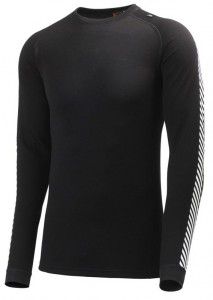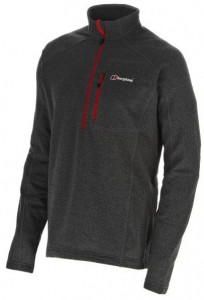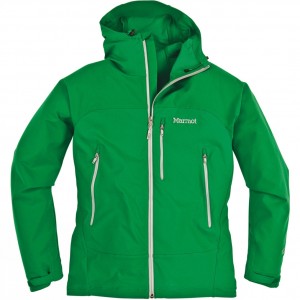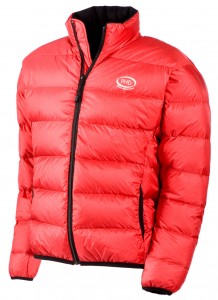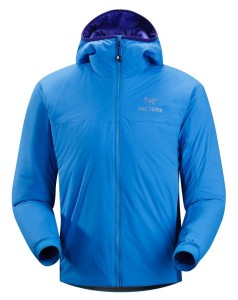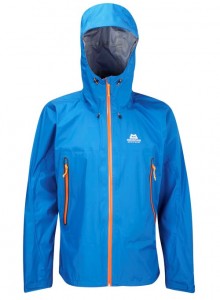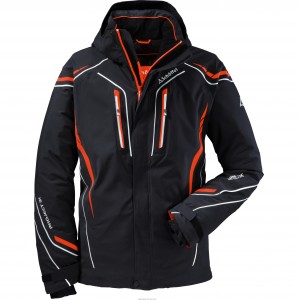Introduction
As our mothers always tell us, layering up is the way to keep warm. Despite all the technical fabrics and innovations we’ve seen in ski equipment over the last few years, this still holds true today. The choice and range of layers now is mind-boggling, but we’ll break this down to explain what you need to know. This all being said, skiing has become so well organized and big resorts so well developed, that people get away with wearing terribly inadequate clothing and still surviving on the slopes. You only have to see the people skiing in that most unsuitable of outdoor clothing, denim jeans, to understand that you can take it too far both ways, both in being over-prepared (thousands of pounds’ worth of technical layers and safety equipment for someone who only skis on-piste in bright sunshine) and under-prepared (the aforementioned wearers of Levi Strauss). Our philosophy is that you’ll have a better time skiing if you’re warm and dry, and you don’t need to spend a fortune to buy the kit you’ll need to achieve this.
Also, it doesn’t hurt to look the part whilst bragging in the bar after the lifts are closed.
Base layers
The place to start is next to the skin. Base layers provide warmth, they wick moisture away from the skin, and they provide a soft layer next to the skin to prevent any rubbing discomfort. In my opinion, on the top half of your body at least, wearing a proper base layer is not optional, it’s absolutely mandatory.
The main choice you’ll make here is whether to use man-made fibres or natural fibres. The most common man-made fibres used in base layers are a combination of polyester and lycra. The most common natural fibre used is wool, usually merino. Never wear cotton next to the skin as it’s not a good insulator when dry, and is a terrible one when wet.
Base layers made from man made fibres are usually cheaper, and in my opinion are better at wicking moisture away from the skin and dry out quicker than wool.
The classic synthetic base layer made by Helly Hansen, this bit of kit is affectionately known as the Smelly Helly.
Wool base layers are usually more expensive, but warmer both when dry and wet. Their main advantage is…smell. Merino wool base layers have the amazing property of not smelling even after being worn for several days. Polyester base layers get stinky very quickly. Just to be fair on the subject, merino does smell like wet wool after being worn during strenuous exercise, but they tend not to smell of body odour.
 Perhaps the original and certainly the best known brand of technical merino wool baselayers is Icebreaker.
Perhaps the original and certainly the best known brand of technical merino wool baselayers is Icebreaker.
So which to go for? Well I’m a huge fan of merino wool base layers, and wear them both when skiing in resorts, and when ski-mountaineering. I’ve worn one merino wool base layer for nine days straight whilst on the Haute Route ski tour, and whilst I wouldn’t have wanted to go out on a date wearing it afterwards, it coped pretty well. A polyester base layer would have been unwearable after one or two days.
That said, for the price of one good quality merino base layer, you could buy several polyester base layers. If you’re going to be able to change base layers regularly, or you don’t care about smelling bad, polyester based base-layers are a good option.
Whichever you go for, I prefer the cut to be close-fitting as it helps the fabric to do its job when it’s next to the skin. I also like a zip neck which allows you to alter your temperature a surprising amount when compared to a non adjustable crew neck.
Mid layers
The next layer should form the bulk of the insulation of your ski kit. Mid layers need to be warm, but breathable. Some mid layers have a small amount of weather proofing (i.e. resistant to a light rain shower) and when the weather is clement can be worn as a top layer. There is a huge range of clothing which fits this description, so it’s almost not worth trying to cover them all here in any detail. We’ll give a little summary:
Fleeces
Fleeces are perhaps the most common mid layer insulator. They provide a good amount of warmth, are cheap, come in many different styles, and most people will already own one. On the downside they will have very little water resistance and very little wind resistance, so can only really be worn when in conjunction with a weatherproof shell, unless you’re absolutely certain that the weather will stay kind.
Everyone owns a fleece don’t they? This is a one of Berghaus’ upmarket Polartec fleeces.
Soft shells
Soft shells are a relatively recent addition to the skier’s wardrobe. They are designed to fall somewhere between the traditional waterproof jacket (now called a “hard shell”) and a fleece. They provide some warmth, are very breathable, slightly stretchy, and offer good wind protection and reasonable rain protection. However they will not cope with prolonged or heavy rain. There are a few different varieties of fabric which has become known as a soft shell, but in their purest form they are definitely shell-like (as opposed to a fluffy fleece), but thicker and heavier than a pure “hard shell” waterproof jacket. They do actually feel softer to the touch than a traditional waterproof, and don’t rustle as much when the layers rub together. They don’t usually have any built-in insulation (other than that of the shell itself).
This is one of Marmot’s soft shell range, the Tempo Hoody.
Down insulation
Down is an incredible insulator. Good quality down (measure by the amount of “loft”, or fluffiness) is warmer by weight than any current man made insulation. It’s compressible, so a down jacket can be packed into a very small bag, and is naturally breathable. The problem with down, apart from it being quite expensive, is that it’s useless when wet, and worse, if down gets properly wet it can be ruined for good. Down is a good option for those who get cold easily, and who don’t expect to be skiing in an active, strenuous fashion. It’s not good if you’re going to exercise hard and sweat a lot (it’ll get the down wet) or if you’re skiing in wet conditions. Even when under a waterproof hard shell, you may find that the inevitable condensation and leakage will get through to your precious jacket. If your down jacket gets dirty it will need to be cleaned by a specialist down-cleaning company.
PHD are a small independent British firm which specialises in very high quality down equipment. This is the PHD Minimus Jacket – very light, very warm.
Man made insulation
Many companies make synthetic insulation which attempts to match down for heat retention properties, with three of the biggest brands being Primaloft, Coreloft, and Thinsulate. By weight they are not as warm as natural down, but they have one big advantage – their performance in the wet. These synthetic fibres retain a lot of their insulating properties in the wet, and of course won’t be ruined by the water. As such they can often be washed in your home washing machine. As the fibres are light and fluffy and don’t have their own “structural integrity” (a climbing partner once tore my jacket with his crampon and the lining looks like cotton wool) they need to be held in another layer. Usually this will be a light, breathable fabric, with minimal waterproofing, but some windproofing.
The awesome Arc’teryx Atom Lt Hoody midlayer
I personally use a lightweight, breathable jacket with man made insulation. It’s warm enough for most conditions, isn’t as fragile as down, can be packed into a small space when not in use, and can be washed easily.
Shells
Should the weather be cold, windy, or wet, you will need a hard shell to keep out the elements. That said, if you have a good quality hard shell, there’s no reason you can’t wear it all the time when skiing, rather than having it as something to bring out when the weather worsens. Hard shells are the most waterproof of the types of clothing talked about so far, and even cheap and basic hard shells usually have some measure of breathability too. Gone are the days when waterproofs were like bin liners, which were waterproof but the amount of condensation on the inside made it feel like the water was streaming through from the outside. Modern fabrics can keep you dry in all but the most torrential of downpours, but breath well enough to allow for serious levels of exercise without condensation building on the inside. The most well known of the waterproof but breathable fabrics is Gore-Tex, but there are plenty of competitors out there, and many big clothing manufacturers have their own technology. There is generally a trade off between waterproofness, breathability, and cost.
I think it’s worth spending money on a good hard shell. If you get it in muted colours you have a jacket which will serve you well at home as well as on the slopes. It can be combined with mid layers and base layers to cope in a huge variety of conditions. As it’s just a shell, with no insulation, it can be worn to protect from summer showers, as well as from winter snow. It’s a truly versatile piece of equipment.
I like a hard shell with a built in hood, which provides instant extra warmth and protection from the elements when needed, and helps to keep your neck protected when you’re not wearing it. This type of hood also tends to mean that the jacket comes up very high at the front too when it’s fully zipped up, protecting the lips and mouth from the weather when it’s really bad. Get a climbing type jacket which has a hood big enough to fit over a helmet so that you can pull it over without removing your head protection. Whilst this won’t be comfortable for skiing as it will limit your head movement range, it’s great when waiting in the cold.
Mountain Equipment’s excellent Firefox lightweight shell jacket with GORE TEX Active Shell Technology
Combination products
This isn’t a term that’s used in the market, it’s my own term to cover ski kit that has insulation, as well as a waterproof shell, all together in one bulky item of clothing. This is what most people will think of when using the term “ski jacket” or “snowboarding jacket”. These jackets can be an excellent option for those who don’t want to have to worry about or think about layering, for those who are happy to have a dedicated jacket for winter sports (as they’re often too warm to use when back in our respective home countries), or for those who want to get a “fashionable” ski jacket with bright lairy colours and patterns. In fact, specialist snow sports jackets that fit this “combination” description often only seem to come in bright colours and baggy cuts. As they’re specifically designed for winter sports you’ll find that they work well in most conditions for in-bounds skiing (i.e. not serious off piste), and take the hassle out of layering. The downsides to these jackets are their lack of flexibility, as they’re warm enough that you probably won’t need a midlayer, but you’ll immediately be far too hot as soon as you’re inside in a lift queue or coming in to a restaurant, and their bulky and awkward to carry around when you’re not wearing them. Conversely they might not be warm enough for the very coldest conditions but you won’t want to carry extra insulating layers when you’re already using a bulky jacket. And finally, on those horrible warm days when the snow’s wet, and sometimes it’s raining at lower altitudes, these jackets will tend not to be as waterproof as the best hard shells, and once they’re wet you can’t just switch out layers – you’re stuck with a wet jacket.
This is from one of Germany’s top ski clothing brands, the Schoeffel Johnson
Salopettes
Salopettes are the European term for what the North American market calls ski-pants. Essentially, unless you live somewhere very cold, you’ll have no use for salopettes apart from your annual skiing holiday – salopettes are warm insulated trousers.
My view on salopettes is that you don’t need to spend a tremendous amount of money on them. Your legs are much more able to deal with inclement conditions than your upper body, and I’ve never felt the need to spend the kind of money that I readily spend on jackets on salopettes.
For regular on-piste skiing a normal pair of breathable, warm salopettes will be fine. You will sweat much less from your legs than from your upper body so breathability isn’t as crucial. Some waterproofness is good, especially if you’re learning and spending a significant amount of time sitting on the snow!
One thing to look out for is the waist height – often ski specific salopettes have a high waist and braces, which helps to prevent snow from getting inside your trousers if you have a crash. Snowboard inspired fashion has seen a big increase in the number of ski pants with low cut waists – which looks cool but isn’t terribly practical.
If you plan on strenuous activity you may want to use the same layer method we discussed above for the upper body. This is what I recommend for ski touring. I have merino wool thermal leggings, and wear waterproof breathable shell trousers over the top. Another advantage of this is that these trousers are fine to use as waterproof trousers if you’re out walking at home in the rain, whereas salopettes can only really be used in a ski resort.
Some ski trousers have reinforced patches strategically placed on the knees, the bum, and around the ankles. I think it’s worth looking for a pair with these patches – especially around the ankles. You’ll find that without knowing it you’ll frequently catch the inner edges of your ski on the inside of the opposite ankle, and ski trousers without reinforcement here will quickly rip.
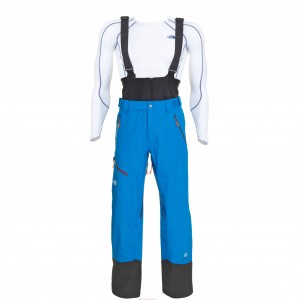 The North Face Enzo pant is a GORE TEX hard shell salopette with high bib waist and reinforced ankles
The North Face Enzo pant is a GORE TEX hard shell salopette with high bib waist and reinforced ankles


